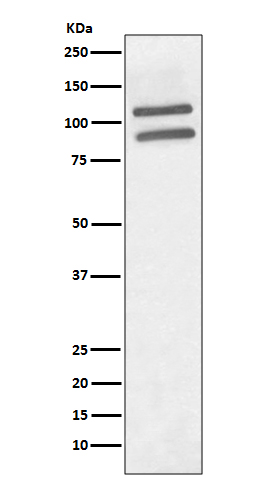产品名称
PML (11A3) Rabbit Monoclonal Antibody
别名
Protein PML; Promyelocytic leukemia protein; RING finger protein 71; Tripartite motif-containing protein 19; MYL; PP8675; RNF71; TRIM19;
纯度
Affinity-chromatography
蛋白名称
MYL, PP8675, RNF71, TRIM19
存储缓冲液
Rabbit IgG in phosphate buffered saline , pH 7.4, 150mM NaCl, 0.02% New type preservative N and 50% glycerol. Store at +4°C short term. Store at -20°C long term. Avoid freeze / thaw cycle.
Human Swissprot No.
P29590
稀释度
WB 1:500~1:2000 IHC 1:100~1:500 ICC/IF 1:50~1:200 IP 1:50 FC 1:200
注意事项
PML Antibody is for research use only and not for use in diagnostic or therapeutic procedures.
细胞定位
Nucleus. Nucleus, nucleoplasm. Cytoplasm. Nucleus, PML body. Nucleus, nucleolus. Endoplasmic reticulum membrane; Peripheral membrane protein; Cytoplasmic side. Early endosome membrane; Peripheral membrane protein; Cytoplasmic side Note=Isoform PML-1 can shuttle between the nucleus and cytoplasm Isoform PML-2, isoform PML-3, isoform PML-4, isoform PML-5 and isoform PML-6 are nuclear isoforms whereas isoform PML-7 and isoform PML-14 lacking the nuclear localization signal are cytoplasmic isoforms Detected in the nucleolus after DNA damage. Acetylation at Lys-487 is essential for its nuclear localization. Within the nucleus, most of PML is expressed in the diffuse nuclear fraction of the nucleoplasm and only a small fraction is found in the matrix-associated nuclear bodies (PML-NBs). The transfer of PML from the nucleoplasm to PML-NBs depends on its phosphorylation and sumoylation. The B1 box and the RING finger are also required for the localization in PML-NBs. Also found in specific membrane structures termed mitochondria-associated membranes (MAMs) which connect the endoplasmic reticulum (ER) and the mitochondria. Sequestered in the cytoplasm by interaction with rabies virus phosphoprotein
功能
Functions via its association with PML-nuclear bodies (PML- NBs) in a wide range of important cellular processes, including tumor suppression, transcriptional regulation, apoptosis, senescence, DNA damage response, and viral defense mechanisms. Acts as the scaffold of PML-NBs allowing other proteins to shuttle in and out, a process which is regulated by SUMO-mediated modifications and interactions. Isoform PML-4 has a multifaceted role in the regulation of apoptosis and growth suppression: activates RB1 and inhibits AKT1 via interactions with PP1 and PP2A phosphatases respectively, negatively affects the PI3K pathway by inhibiting MTOR and activating PTEN, and positively regulates p53/TP53 by acting at different levels (by promoting its acetylation and phosphorylation and by inhibiting its MDM2-dependent degradation). Isoform PML-4 also: acts as a transcriptional repressor of TBX2 during cellular senescence and the repression is dependent on a functional RBL2/E2F4 repressor complex, regulates double-strand break repair in gamma-irradiation-induced DNA damage responses via its interaction with WRN, acts as a negative regulator of telomerase by interacting with TERT, and regulates PER2 nuclear localization and circadian function. Isoform PML-6 inhibits specifically the activity of the tetrameric form of PKM. The nuclear isoforms (isoform PML-1, isoform PML-2, isoform PML-3, isoform PML-4 and isoform PML-5) in concert with SATB1 are involved in local chromatin-loop remodeling and gene expression regulation at the MHC-I locus. Isoform PML-2 is required for efficient IFN-gamma induced MHC II gene transcription via regulation of CIITA. Cytoplasmic PML is involved in the regulation of the TGF-beta signaling pathway. PML also regulates transcription activity of ELF4 and can act as an important mediator for TNF-alpha- and IFN-alpha-mediated inhibition of endothelial cell network formation and migration.

